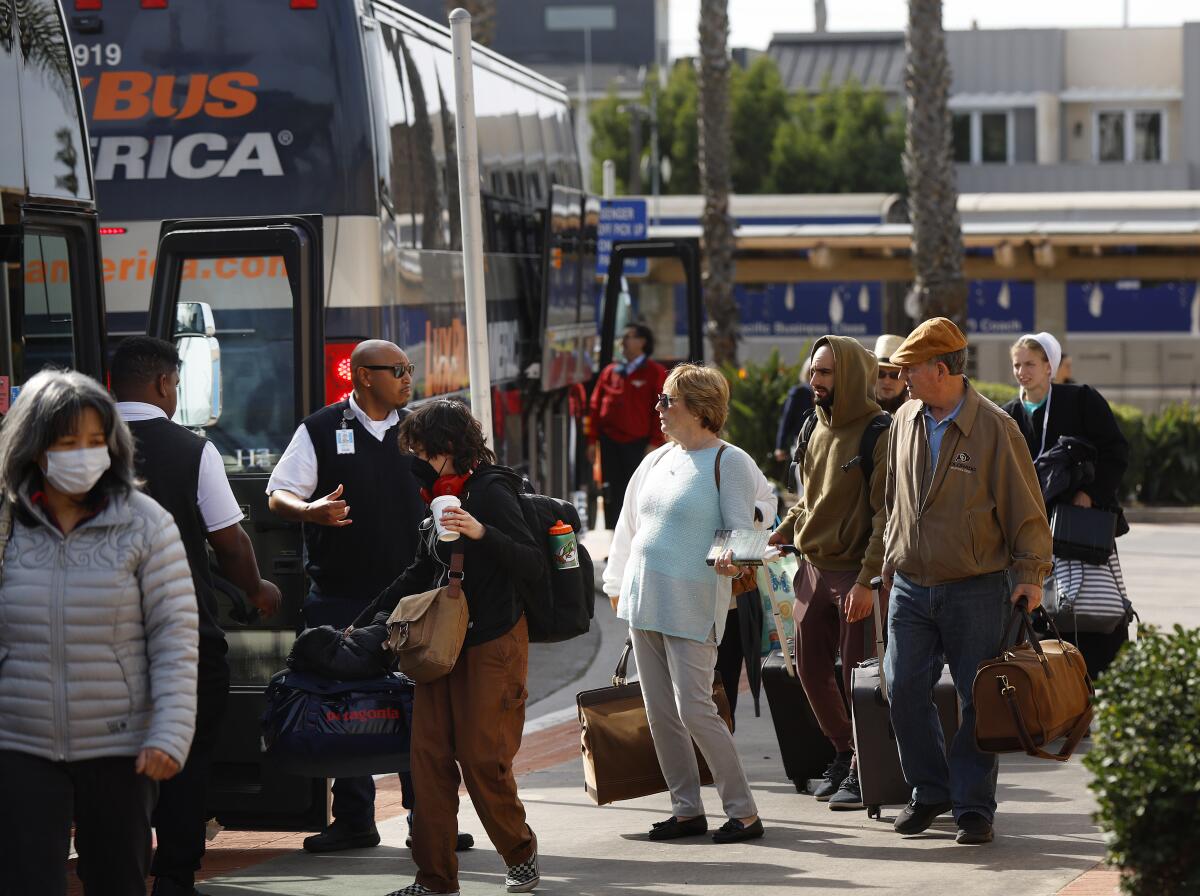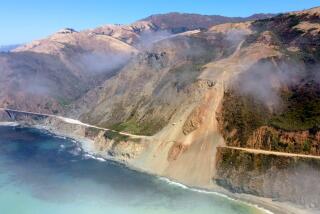Amtrak riders use ‘bus bridge’ between Oceanside and Irvine

- Share via
SAN DIEGO — The “bus bridge” between Oceanside and Irvine has been going for more than three months now, but Amtrak riders seem to be taking it in stride.
It’s the only way for train passengers between San Diego and Orange counties to get around the landslide stabilization project in San Clemente, which is likely to continue another month or longer.
“It really doesn’t bother me at all,” said a rider named Larry, who gave only his first name. He said he rides the train about once a month to San Diego from his home in Fullerton in Orange County.
“You walk about 20 steps and get on a bus,” he said Wednesday during the brief stopover at the Oceanside Transit Center. “It’s pretty quick.”
The bus portion of the trip takes about one hour, according to the Amtrak schedule. Amtrak contracts with LuxBus America and uses 56-seat “coaches” with restrooms, cargo holds, overhead luggage bays, handicapped access and more.
The total trip — train from Fullerton to Irvine, bus from Irvine to Oceanside, train from Oceanside to Santa Fe Station in San Diego, or vice versa — takes 2½ to three hours depending on the time of day and costs about $36 one way for coach or $56 for business class.
Another passenger, Malik Drammh, said Wednesday it was his first time riding Amtrak. He was traveling one way from Los Angeles to San Diego and planned to drive back in his brother’s car.
The three-legged trip was a surprise but not a problem, he said.
“I wasn’t really worried about it,” he said.
Fifty to 100 people use the bus bridge on each Amtrak Surfliner run between San Diego and Los Angeles depending on the time and day, said a ticket agent at the Oceanside station.
The detour, which takes passengers in buses onto Interstate 5, has been in place since the end of September, when new movement was detected in the San Clemente slope. The Orange County Transportation Authority, which owns the right of way there, is installing 220 ground anchors in two rows drilled deep into the bedrock to hold back the slow-moving landslide.
The OCTA board of directors declared a local emergency in early October, and said at the time that the stabilization work would take 30 to 45 days to complete. Since then, the projected completion date has been extended several times, largely because of the wet weather, and the work now is expected to be finished by the end of March.
The situation in San Clemente is compounded by erosion. Waves, high tides and storm surge have chewed away the beach at the base of the slope and contributed to the landslide.
In all, the tracks have been pushed 28 inches toward the ocean since September 2021.
Most of that movement occurred after rain storms in 2021, and since then the agency has placed tons of boulder riprap at the base of the slide to help shore up the slope. No new movement has been detected in recent weeks, OCTA officials said.
Buses have long been used to fill in the blanks between passenger trains.
North County Transit District, which operates the Coaster commuter train between Oceanside and San Diego and Sprinter trains between Oceanside and Escondido, uses bus bridges when breakdowns or other situations stop trains.
Generally, the bus takes passengers to the next station where a passenger train is available.
“NCTD uses bus bridges during planned and unplanned service disruptions that prevent the Sprinter or Coaster from reaching the scheduled stops,” said Chris Orlando, chief planning and communications officer at the agency.
“The use of a bus bridge is rare and generally for a brief period of time,” Orlando said in an email Friday. “When they are needed, we work hard to minimize the impact on customers.
“For planned events, it is scheduled in advance and communicated to customers,” he said. “Our operations control center implements bus bridges as soon as possible after an unplanned disruption, using available staff and vehicles from within our fleet.”
In most cases, train service quickly returns to normal, usually the same day.
NCTD has its own erosion problems, particularly along the tracks on the steep bluffs in Del Mar. A series of seawalls, soldier piles and drainage structures have been installed there over the last 20 years, and more construction is planned.
A long-term plan being developed by the San Diego Assn. of Governments would reroute the 1.7 miles of tracks in Del Mar inland through a tunnel. That solution could be completed in 2035 at the earliest, SANDAG has said.
OCTA has said it will consider possible long-term solutions for San Clemente, but so far it has made no progress toward removing the tracks away from the coast.
OCTA has suspended its Metrolink trains from San Clemente to Oceanside during the stabilization project, and no bus bridge is available for Metrolink. Oceanside normally is the southernmost stop on the Metrolink system, which has routes as far north as Ventura and east into Riverside and San Bernardino counties.
Del Mar and San Clemente aren’t the only places where the 140-year-old coastal railroad is subject to erosion.
Amtrak announced Wednesday that as of Thursday because of recent storms, passenger service would be suspended for 10 to 16 days between Goleta, which is just north of Santa Barbara, and San Luis Obispo. No bus bridge is available to close the nearly 100-mile gap.
That problem is the result of damage to a railroad bridge just outside of Goleta, said Robynn Tysver, a communications manager for Union Pacific Railroad.
“Flooding displaced rock at the base of the bridge that we are shoring up or repairing,” Tysver said Thursday. “We have crews on site right now. It could take up to two weeks.”
San Luis Obispo is at the northern end of the 350-mile LOSSAN rail corridor that runs between that city, Los Angeles and San Diego. It is one of the busiest passenger rail lines in the United States, second only to the Northeast Corridor between Washington, D.C., and Boston.
The northern end of the LOSSAN corridor, on the Central California coast, is the most sparsely populated section of the route with just three stations between Goleta and San Luis Obispo.
More to Read
Sign up for Essential California
The most important California stories and recommendations in your inbox every morning.
You may occasionally receive promotional content from the Los Angeles Times.











